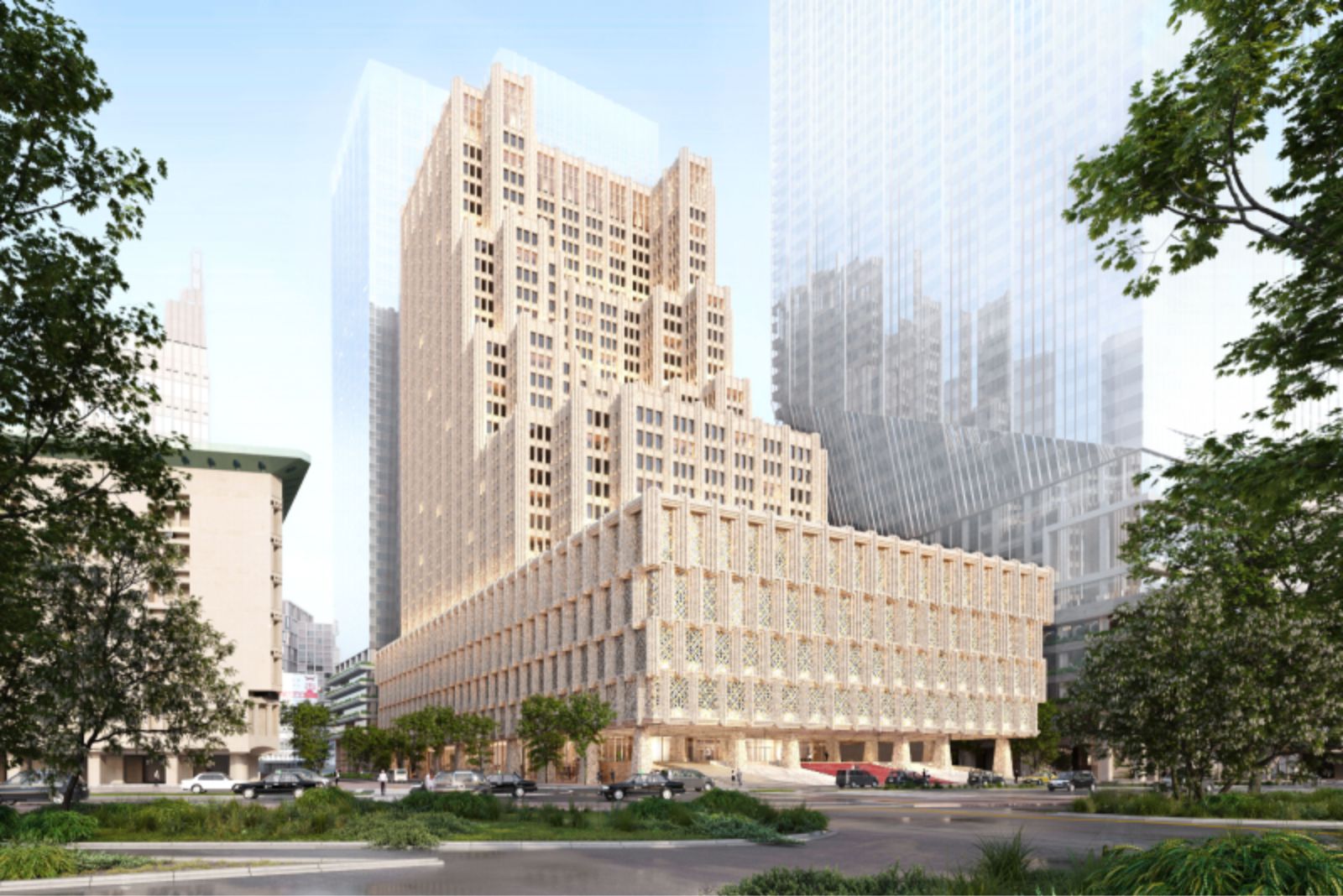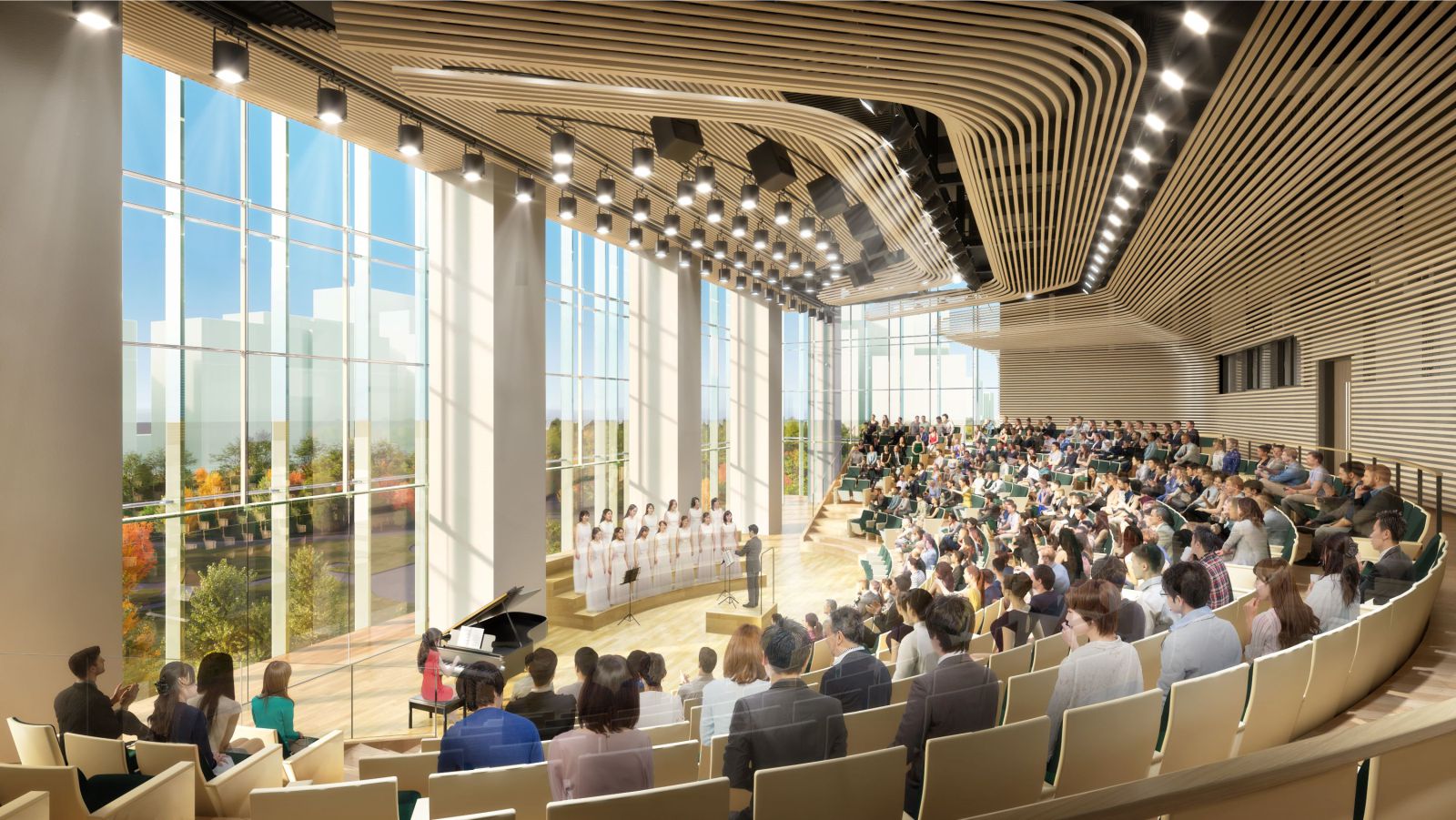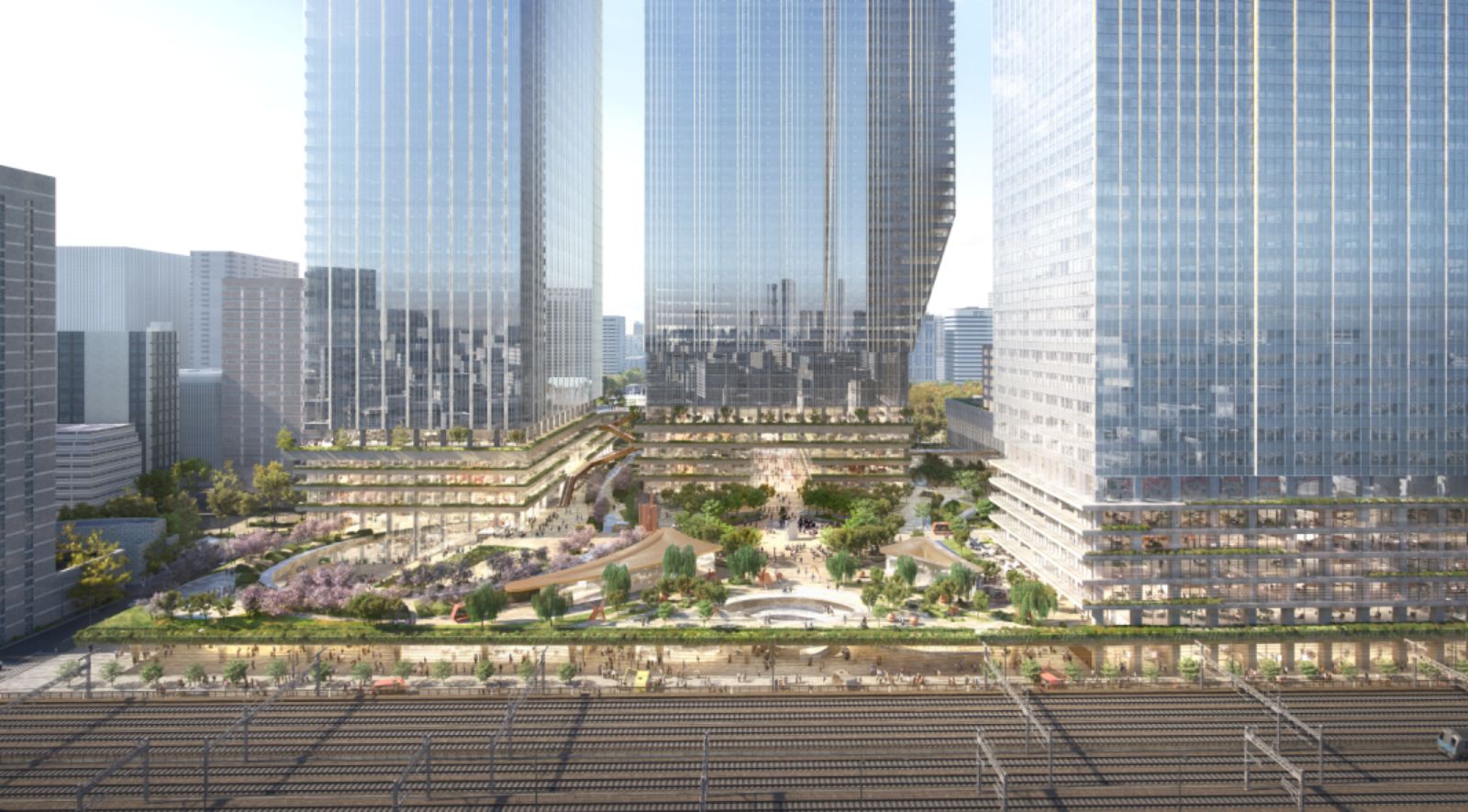PLP Architecture has unveiled their plans for a new district redevelopment in the prestigious Uchisaiwaicho 1-Chome district of Tokyo, a site that is at the very centre of Japanese culture, economy and politics. PLP is the master designer and placemaking strategist for the entire 1.1 million square metre development, the largest in the metropolitan area of Tokyo, as well as the architect for two of the four mixed-use towers on the 6.5-hectare site. The design is for a multi-stakeholder partnership, comprising of ten of Japan’s most prominent companies.
Site Overview
The Tokyo Cross Park development will be the largest regeneration development in the metropolitan area of Tokyo, with a total floor area of 1.1 million square metres. The site connects to the 16-hectare Hibiya public park and will include four towers, a 31-metre-tall podium with an elevated green public realm, and a 2-hectare public plaza. The programme contains offices, commercial facilities, hotels, residential, co-creation spaces and an extensive indoor and outdoor public realm.

The site consists of three districts: North, Central and South. In the North District are the Imperial Hotel’s new main building, designed by ATTA, and the PLP Architecture designed North Tower, which offers premium hospitality-oriented offices, commercial facilities, serviced flats and rental housing. In the Central District, which is connected to Hibiya Park by an open-air ‘park bridge’, the Central Tower, also designed by PLP, will be equipped with offices, a hotel, banquet hall, a multipurpose hall and cross-industry co-creation hubs.
In the South District, the South Tower, designed by Nikken Sekkei, will comprise of offices, a hotel and wellness promotion facilities. The ‘park bridge’ connection to Hibiya Park creates a larger loop of pedestrian walkways, linking to surrounding stations and districts. This creates an expansive pedestrian network, with safe and green routes, in a heavily urban area that has previously been dominated by vehicular traffic. The Tokyo Cross Park Vision – 3 Uniting Concepts:

Crossover 1 – Uniting natural life and urban life
The Tokyo Cross Park envisions the growth of the capital’s green space, outwards from the Imperial Palace and Hibiya Park into the urban districts of the city. The Uchisaiwaicho district will connect its natural environment with that of the park through two pedestrian ‘park bridges’ that span the busy dividing road. This link creates a 32-hectare human-centric and walkable environment rich in wildlife, water, and public meeting spaces aimed at bringing a focus on wellbeing, sociability and connection to nature.
Crossover 2 – Uniting Tokyo’s top talent
The development is in the most prominent area of Tokyo and it is a short distance from the old CBD areas of Otemachi and Marunouchi, the culture, retail and leisure districts of Yarakucho and Ginza, the Kasumigaseki governmental district, and the new CBDs of Shinbashi and Toranomon. PLP Architecture has designed the site for maximum possible connectivity to encourage top talents – people, institutions and companies – to engage in this new district. A programme of hyper-mixed functions, amenities and co-creation spaces provide the framework for the ‘best of Tokyo’.

Crossover 3 – Uniting Japan’s top ten companies
Ten leading Japanese companies, which are rooted in this site, have been brought together to co-create ideas for the future development of Japan. By uniting each individual strength, such as urban development, digital technology, hospitality, wellbeing, carbon-neutrality and disaster prevention, the masterplan will establish a next-generation smart city that aims to tackle critical urban issues and generate new value for the future. The Tokyo Cross Park Vision – 5 Principles:
1 – A human-centric city
PLP’s masterplan aims to establish a truly ‘human-centric’ city. Experiences throughout the site will improve people’s wellbeing, give them a positive connection to nature in the city, and provide spaces to freely share ideas. The site is a nexus of Tokyo’s major districts and with this provides spaces that encourage the wider community to congregate, hold events, share knowledge and showcase their creativity. With these, the masterplan establishes an unparalleled urban development for Tokyo, which will offer increasingly richer and more vibrant experiences as it develops.

2 – Urban development x digital
The district will be supported by advanced digital infrastructure, including digital twins, which will enable it to become a cross-disciplinary third-generation smart city. This technology will be used to enhance the experience of people in the district, helping services provide increasing value by naturally and constantly evolving to suit the needs of individual users. In part, the digital infrastructure will provide an effective co-creation environment, which will continuously evolve based on the data it collects. This progression will largely be experienced in the dedicated co-creation hub as well as the large main public realm.
3 – “Omotenashi”
The Japanese take pride in the world-class hospitality that they offer, embodied in the term “Omotenashi”. In addition to the rejuvenation of the new Imperial Hotel main building, a separate small super-luxury hotel, owned by the NTT Group and operated by the Imperial Hotel, will open in the Central Tower. A wellness-focused hotel will also open in the South Tower. For more permanent residents, the North Tower will accommodate rental housing and serviced apartments, introducing a new premium level ‘live’ offer into the Hibiya/Uchisaiwaicho area. In the Central Tower, there will be a new multi-purpose hall operated by the NTT Group and a premium banquet hall owned by Mitsui Fudosan and operated by the Imperial Hotel.

4 – Evolving Wellbeing
The location of the site, with its connection to Hibiya Park and the gardens of the Imperial Palace, provides opportunities to bring natural elements into the site as an extension of these green spaces. This lush environment, coupled with quality-of-life and community focused spaces, aims to encourage wellbeing throughout the urban block. Spaces that have been designed to promote wellbeing will be supported by the site’s digital infrastructure. Data will be collected and analysed to constantly inform and provide the most optimal physically, mentally and socially beneficial information, services and experiences.
5 – Reaching Carbon Negative
The Tokyo Cross Park will become a flagship for sustainable development in the country and will showcase the possibility of reaching the government’s target of carbon neutrality by 2050. The project aims to achieve zero CO2 emissions with a centralised masterplan-wide energy strategy at the time of completion. Adding to this, by introducing new environmental technologies such as carbon absorbing technology, the masterplan aims to be carbon negative in the future. Source by PLP Architecture.

- Location: Tokyo, Japan
- Architect: PLP Architecture
- Business operator: Imperial Hotel Ltd., Mitsui Fudosan Co. Ltd. (North Tower), NTT Urban Solutions Co.1, Kokyo Tatemono Co., TEPCO Power Grid Inc.2, Mitsui Fudosan Co. (Central Tower), Dai-ichi Life Insurance Co., Chuo-Nittochi Co., Tokyo Century Corporation, TEPCO Power Grid Inc.*2 (South Tower)
- Site area: 6.5 ha
- Total floor area: Approx. 1.1 million
- Completion: 2037
- Images: Courtesy of PLP Architecture










